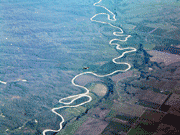|
|
 |
||||||||||
|
|||||||||||
|
|||||||||||
Way Downstream
In Annapolis, Debbie Schachner strolled into Bay Weekly on her way to Delaware. She was walking; had been all the way from California. With a large backpack and bedroll strapped to her back, Schachner sat a spell to report on her American Discovery Trail hike to raise $47,000 for construction of a public library in Timau, Kenya. “One hundred percent of your donation will be used for the library project. I spend no money on overhead; it all comes out of my own pocket,” she said. Follow Schachner on her journey at www.walkingwithfaith.com. …
In Maryland, the Clean Water Act has scofflaws galore. A new report by Environment Maryland used 2005 EPA data to illustrate that many polluters still haven’t met original goals that dirty industries need to clean up their act. Thirty-seven percent of industrial and municipal facilities discharged, on average, 84.1 percent more pollution into our waterways than the Clean Water Act allows. Yet we’re law abiding compared to the national average. Across the U.S., 57 percent of industrial and municipal sites topped their limits at least once during 2005, on average exceeding pollution permits by 263 percent. Think there’s any correlation between those figures and these? 39 percent of U.S. rivers, 46 percent of lakes and 51 percent of estuaries are too dirty for safe fishing or swimming … In Washington, D.C., the National Research Council had this optimistic advice this week in a massive report studying what’s wrong with the Mississippi River: In terms of coordination, check out how we do it along Chesapeake Bay. The report took the U.S. EPA to task for failing to keep tabs on Mark Twain’s river, which is beset by problems old and new, among them nutrient pollution pouring off all those Midwestern farms. Chesapeake Bay, the report said, “offers an example of how the EPA, working collaboratively with states, can make progress toward nutrient reductions” …
“We’ve shipped to Fairbanks, Alaska. We’ve shipped to Hawaii,” the owner of Fenwick Crab House in Fenwick Island told the paper, adding that its website, CrabCakeExpress.com provides 20 percent of its sales … Our Creature Feature comes from the eastern African nation of Uganda, where you may want to visit if you have a yet to see rare mountain gorillas before they’re gone. With just 750 or so remaining, mountain gorillas are one of the world’s most endangered species, and they’re found only in the dense forests where Uganda shares borders with Rwanda and eastern Congo. Tourist groups of eight people visit social groups of six or seven gorillas, making the interaction, well, cozy. Uganda is preparing for more gorilla visitors, hoping to increase tourism revenues that already bring in $200 million. |
|||||||||||
|
|||||||||||
|
|
|||||||||||
|
© COPYRIGHT 2007 by New Bay Enterprises, Inc. All rights reserved.
|
|||||||||||


 In Delaware, the News Journal reports that some state crabbers sell their catch along the road while others prefer the information superhighway. The paper quotes watermen and crab houses as saying they’re doing more and more business over the Internet, shipping crabs live, steamed and in crabcakes across the country.
In Delaware, the News Journal reports that some state crabbers sell their catch along the road while others prefer the information superhighway. The paper quotes watermen and crab houses as saying they’re doing more and more business over the Internet, shipping crabs live, steamed and in crabcakes across the country.